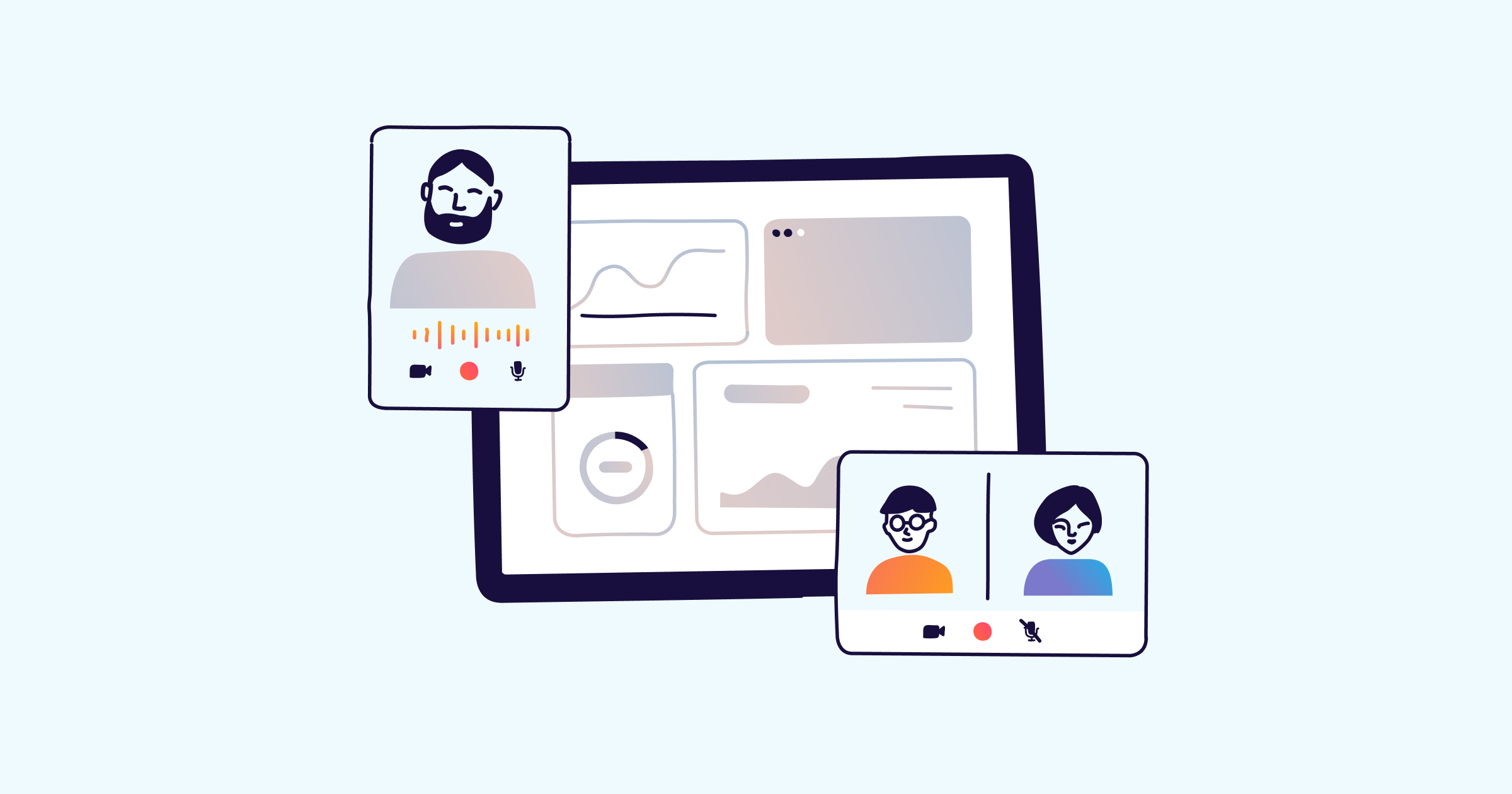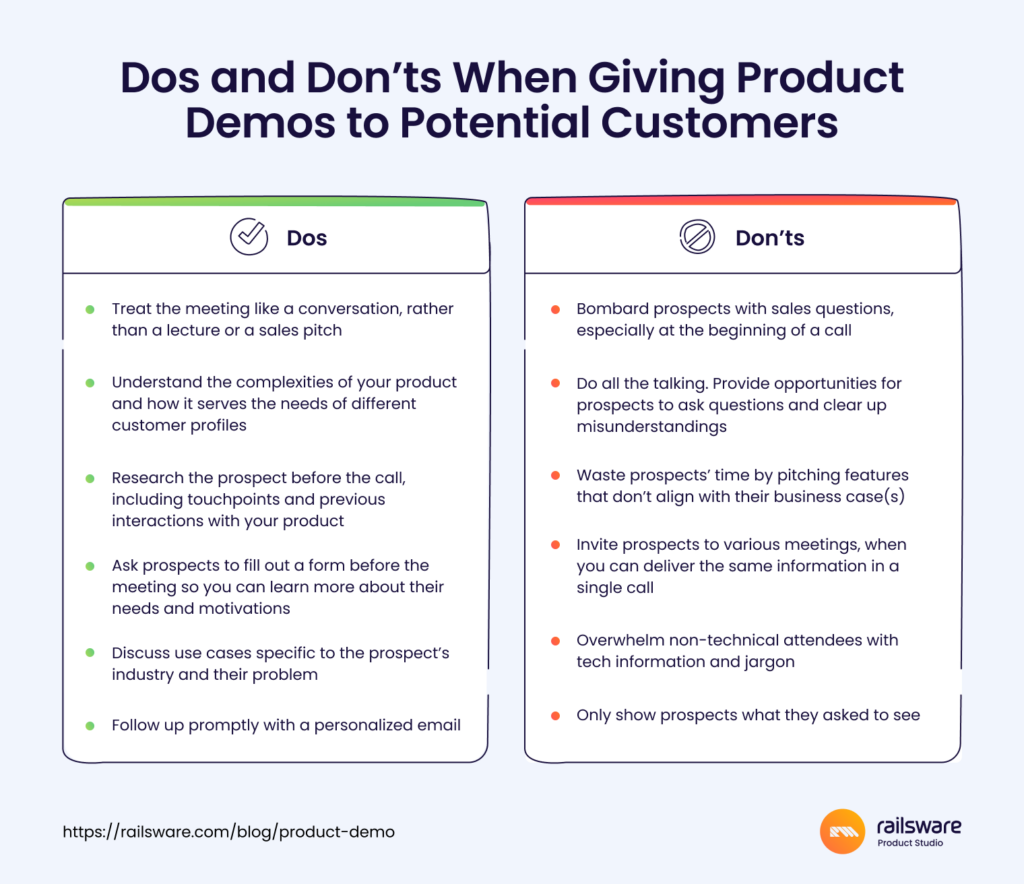For this article, we spoke to Julia Romanenkova, our TitanApps Product Lead, and Oleksandr Khrystiuk, our Coupler.io Sales Account Manager, to learn what it takes to deliver outstanding product demos.
We’ve packaged their advice into this ‘Before, During, and After’ guide. So, whether you’re a product manager preparing to host your first sales demo, or a junior sales rep still learning the ropes, you’ll find a bunch of practical tips here.

Why we run product demos at Railsware
Let’s start with a little background. At Railsware, we host product demonstrations for a few different reasons: to help close deals for our SaaS products, to onboard new customers or team members, to showcase our products to solution/affiliate partners, and to keep the wider team up-to-date with product changes. But today, we’ll focus on the first one: running product demos to acquire new customers.
These are 30-minute to one-hour live demos that take place online. Prospects can hit the ‘Book a demo’ or ‘Talk to an Expert’ buttons on one of our product websites – Coupler.io, Mailtrap, and TitanApps – and automatically receive a Calendly link. Once the meeting is set up, we start the following process behind the scenes…
Preparing for the demo
1. Do your research
Learn all that you can about the prospective customer before the scheduled demo. Ideally, you should ask them to fill out a short survey a few days in advance (we use Google Forms, Typeform, or even Typeform alternatives).
You can also share the survey via a QR code in your meeting invites or reminder emails to make it more accessible. You might include questions like:
- Is there something in particular you would like to learn more about during our meeting?
- Can you share anything that would help us prepare for the upcoming meeting?
- Do you have any questions about our product?
- Do you need help setting up X feature? (in our Coupler.io product, that’s usually a data import)
Regardless, you can’t count on a survey to give you a well-rounded picture of the prospect’s needs. Sometimes, they might not even fill it out (although you can always follow up via email before the call).
In any case, you should gather information from a variety of other sources, such as their chat history with your support team, early interactions with the product, your internal Slack discussions, LinkedIn, email threads, and notes inside the calendar invite itself.
Exactly where you go to dig for information will depend on your sales/customer acquisition processes, the tools you use, and the maturity of your product/organization.
But the ‘how’ of pre-demo customer research isn’t what’s important; it’s more about grasping the problem at hand. You need to understand what the prospect expects from the call (product walkthrough, help with a specific issue) and how you can best serve them.
2. Prep your demo account, product resources, and meeting tools
- Log in to your demo account well in advance of the meeting. Double-check that all features, particularly those your prospect has expressed interest in, work as expected.
- For example, when we prepare for Coupler.io product demos, we make note of the sources/destinations the prospect is asking about (say, Slack to Google Sheets). Shortly before the demo, we execute such an example to review all integration features and ensure the meeting goes as smoothly as possible.
- Even if you know the product inside-out, there’s no harm in revising any brand guidelines, tech documentation, or knowledge bases before a call. It’s also a good idea to have these resources open during the call, so you can refer to them on the fly.
- The rapid growth of TitanApps prompted our marketing team to create a glossary of features. Now, the names and purposes of features are clearly outlined, ensuring consistency when features are discussed with external stakeholders.

Julia Romanenkova
Product Lead at TitanApps
About 50% of the time, something goes wrong. A new bug appears, the server refuses the connection, or someone managed to delete your data. You can’t prepare for everything, but whatever happens, don’t panic – other people are used to dealing with mishaps like that. Make a joke about it, find a quick solution, or move on to something else.
3. Invite the right team specialists to the call (optional)
Maybe you don’t have a dedicated sales team for your product. Or maybe you have an MVP/growing product and you’re preparing to acquire your first customers.
In either case, it’s good to have more than one product representative attend a call with potential customers. The key is to invite a few team members with different roles and skill sets. For instance, if you know that the prospect wants to discuss a tech integration, you would invite an engineer to the call. If the prospect expressed interest in promoting your product, then a sales representative is a must-have attendee.
- As we mentioned, we’re currently growing our TitanApps ecosystem, and with scaled marketing efforts come a lot of product demos. Since most of our Smart Tools are MVPs, and we don’t have a dedicated sales team, product demos are attended by a product manager, marketing lead, sales account manager, and even our Railsware CEO.
How to run a great product demo
Don’t be ‘salesy’
A product demo isn’t the same as a sales pitch. Rather, it should have the cadence and lightheartedness of a conversation. So, start the call with a few minutes of small talk, and then ask the prospect to describe the problem they are trying to solve.
For example, you might ask a variation of: ‘We would love to hear more about what your company does and what you’d like to accomplish by using a product like ours?’
Whatever you do, don’t overwhelm the prospect with salesy, intrusive questions – especially at the beginning. Show a genuine interest in their problem and focus on the solutions you can bring.
Show value right away
Don’t just explain why your product is more unique than market alternatives. Instead, show the prospect exactly what they have to gain by choosing your solution.

Oleksandr Khrystiuk
Sales Account Manager at Coupler.io
I believe in the product-led growth approach. Simply put: If your product doesn’t do what it’s advertised to do, nobody’s going to buy it. A demo is an opportunity to highlight product value. Show people what they can achieve, share tailored use case examples, and explain what else is possible.
Share use cases that align with their needs. For example, if you have a project management platform, and the prospect mentioned they are struggling to keep their remote team connected, highlight features that empower communication and collaboration. Explain how using X feature can help them achieve their business goals (e.g. increased productivity, higher morale, time/money savings, etc.).
Briefly introduce other features that the customer could potentially benefit from, based on their industry/niche/specific problem. Mention upcoming releases in your public roadmap (if you have one), and explain how they can reach out to you with feedback or feature requests in the future.
For more on this topic, read our guide on how to define, create, and measure product value.
Don’t delve into the technical intricacies of your solution with a marketing manager or business development representative. You don’t need to prepare a script in advance, but you should always cater to the audience’s knowledge level.
This is easier to do when you understand who your different customers are. That’s why we’d recommend using the Jobs to Be Done framework before you start your sales activities. The framework will allow you to flesh out customer profiles (for example, at Coupler.io, we have about 6) and gain a deeper understanding of their pain points. Then, you can tailor the demo content to each of your profile’s needs.
Collect BANT information
BANT is a sales qualification technique and an acronym for Budget, Authority, Need, and Timing. By getting answers to BANT questions, you’ll be better prepared to guide the prospect during the next steps. It’s also crucial data for your sales metrics. Comparing BANT and PACT data helps the sales team prepare more effective strategies for SaaS businesses.
Budget: What pricing plan are they considering?
Authority: Who is the decision-maker?
Need: What impact will it have on the business if they don’t solve the problem?
Timing: How quickly do they need to implement the product and how urgent is their use case?
The key is to ask these questions gently, and with discretion. As we mentioned above: Instead of asking ‘What is your budget?’, share the screen with your pricing plans and ask which one they’ve been considering. Prompt people to share what they’re comfortable with, and don’t be pushy.
How to know if a sales demo went well?
Truthfully, it won’t take long to find out if your product demonstration was successful. In the days or weeks following, the prospect will either engage with your product/team in some new way (e.g. subscribe, promote to a higher pricing tier, join your partnership program, ask more questions), or they won’t. It’s that simple.
But while you’re waiting to see, here are a couple of clues that your meeting went well:
- They asked the right questions. Did they show interest in certain features or functionality? Did they ask for clarification on some of your points? Engaged prospects don’t typically stay silent, so if they ask a lot of specific questions, you might have a winner on your hands.
- You caught an Aha! moment. Usually, when prospects initiate demo calls, it’s because they’ve got a handful of questions they need answers to. Maybe they don’t understand how some aspect of the product works, or how your affiliate program can benefit them. If you answered their questions and saw a ‘Hey, I get it now’ moment, that’s a good sign.
Even if your demo didn’t help you close a deal, don’t write it off as a waste of time. Live demos are excellent opportunities to gather feedback about your product. Think of it this way: an unsuccessful demo is just another CustDev session ticked off your list. And that’s especially valuable when you’ve got an early-stage product or you’re planning some new features. Use the information your prospects shared to build a more robust, competitive solution.
What to do after the product demo
Organize your learnings
Create a central hub for documenting call notes and results. You don’t need anything fancy; a simple spreadsheet can suffice. This will help you measure progress in sales activities and track success over time. It can also be a valuable resource for other team members, such as customer support specialists. We’d recommend using a sales CRM system, like Pipedrive, to keep a more detailed account of the client profile.
Follow up promptly
Shortly after the call, send an email with a link to the recording (in case they need to rewatch it later) and links to other relevant resources. For example, depending on their use case(s), you might link to the product help center, demo videos of features, or how-to articles from the blog.
Don’t forget to attach sales assets too, such as a one-pager or your sales deck – particularly if the potential customer is comparing your offering against other providers.
Keep an eye on new subscribers
In the days and few weeks following the demo, look out for the prospect in your list of new subscribers (Tip: you might even automate these notifications). If there is little activity in their account, or they haven’t signed up at all, you could send one last follow-up to find out where they stand. If you don’t get a response, it’s time to move on.
Tools for product demos
- Calendly – for scheduling meetings without any back-and-forth hassle.
- Zoom – for running meetings with multiple participants and recording calls.
- Riverside – for transcriptions of audio files, so you don’t have to take detailed notes during the call
- Google Docs – for taking quick notes throughout the meeting
- Google Sheets – for logging notes after the call and maintaining a database of product demo results.
- Coda – for documenting repeatable sales processes, such as how to run an ideal demo call.
Final takeaways
Now let’s wrap this article up with a reminder of the most important dos and don’ts for running product demos:

Heads up – there’s more where this came from! Railswarians regularly share expert advice on our blog, on everything from how to avoid product management pitfalls, to how to get the first paying customers for your new product. Browse our latest posts to learn something new and get a sense of how we do things here :)